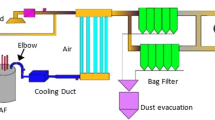Abstract
To predict three-dimensional temperature distribution of molten aluminum and its influencing factors inside an industrial aluminum holding furnace, a fluid-solid coupled method was presented. The fluid-solid coupled mathematics models of aluminum holding furnace in the premixed combustion processing were established based on mass conservation, moment conservation, momentum conservation, energy conservation and chemistry species conservation. Computational results agree well with the test data of the typical condition. The maximum combustion temperature is 1 850 K. The average temperature of the molten aluminum is 1 158 K, and the maximum temperature difference is about 240 K. The average temperature increases 0.3 °C while the temperature of combustion air increases 1 °C. The optimal excess air ratio is 1.25–1.30.
Similar content being viewed by others
References
YU Yan-dong, JIANG Hai-yan, LEI Li, ZENG Xiao-qin, ZHAI Chun-quan, DING Wen-jiang. Numerical simulation of die casting process of magnesium alloy [J]. Journal of Central South University: Science and Technology, 2006, 37(5): 867–873. (in Chinese)
NIECKELE A O, NACCACHE M F, GOMES M S P. Numerical modeling of an industrial aluminum melting furnace [J]. Journal of Energy Resources Technology, 2004, 126: 72–80.
ZIMONT V, POLIFKE W, BETTELINI M. An efficient computational model for premixed turbulent combustion at high Reynolds numbers based on a turbulent flame speed closure [J]. Journal of Engineering for Gas Turbins and Powder, 1998, 120(3): 526–532.
WU Wu-hui, LI Shui-ping. Research on numerical simulation of the temperature field in the ceramics rolling kiln [J]. Industry Heat, 2007, 36(3): 35–38. (in Chinese)
TONG Jian-hui, FENG Qing, WANG He-ping. Numerical simulation of the gas flows and temperature field in the firing zone of roller hearth kiln [J]. China Ceramics, 2006(5): 27–30. (in Chinese)
SHEN Jin-lin, HU Ling-yun. Three-dimensional mathematic modeling of turbulent combustion in combustion space of oil-fired float glass melting furnace [C]// The International Conference on Glass XVIII. Shanghai, 1997: 65–71. (in Chinese)
SHEN Jin-lin, ZHU Jian-feng, YAN Hui. Study on mechanism of glass and heat-transfer process in float glass furnace using computer three-dimensional simulation and graphic generation [J]. Glass Technology Glass Archemetry, 1995, 6: 133–139.
NIECKELE A O, NACCACHE M F, GOMES M S P, KOBAYSHI W T. Numerical simulation of a three dimensional aluminum melting furnace [C]// Proc 4th Int Conf on Technology and Combustion for a Clean Environment. Lisbon, 1997, II 36(3): 15–20.
GOMES M S P, NIECKELE A O, NACCACHE M F, KOBAYSHI W T. Numerical investigation of the oxygen enriched combustion process in a cylindrical furnace [C]// Proc 4th Int Conf on Technology and Combustion for a Clean Environment. Lisbon, 1997, II 36(1): 1–5.
NIECKELE A O, NACCACHE M F, GOMES M S P, KOBAYSHI W T. Numerical investigation of the staged versus non-staged combustion process in an aluminum melting furnace [J]. Heat Transfer Division, 1998, 357(1): 253–259.
NIECKELE A O, NACCACHE M F, GOMES M S P, KOBAYSHI W T. The influence of oxygen injection configuration on the performance of an aluminum melting furnace [J]. Heat Transfer Division, 1999, 364(2): 1303–1317.
BREWSTER B S, WEBB B W, MCQUAY M Q, D’AGOSTINI M, BAUKAL C E Jr. Combustion measurements and modelling in an oxygen enriched aluminum-recycling furnace [J]. Journal of the Institute of Energy, 2001, 74: 11–17.
MUKHOPADHYAY A, PURI I K, ZELEPOUGA S, RUE D M. Numerical simulation of methane-air nozzle burners for aluminum remelt furnaces [J]. Heat Transfer Division, 2001, 369(4): 65–71.
ZHANG Li-fen, WU Ding-yi, LIU Zhen-xia. Numerical calculation of the three-dimensional wall temperature of the combustion chamber by using heat-flow coupled method [J]. Turbine Technology, 2006(4): 275–277. (in Chinese)
LUO Qing-guo, LIU Hong-bin, GONG Zheng-bo. Study on the fluid-solid coupled heat transfer of the diesel engine cylinder head [J]. Acta Armamentarii, 2008, 29(7): 669–773.
LIU Shang, SUN De-chuan. Flow-structure coupled heat transfer calculation for a diffusion flame experimental burner [J]. Journal of Propulsion Technology, 2008, 29(6): 257–261.
FAN Qun-bo, WANG Lu, WANG Fu-chi. Numerical simulation of temperature and velocity fields in plasma spray [J]. Journal of Central South University of Technology, 2007, 14(4): 496–499.
Author information
Authors and Affiliations
Corresponding author
Additional information
Foundation item: Project(2006AA03Z523) supported by the National High-Tech Research and Development Program of China; Project(08C26224302178) supported by the Innovation Foundation of Central South University, China
Rights and permissions
About this article
Cite this article
Zhou, Nj., Zhou, Sh., Zhang, Jq. et al. Numerical simulation of aluminum holding furnace with fluid-solid coupled heat transfer. J. Cent. South Univ. Technol. 17, 1389–1394 (2010). https://doi.org/10.1007/s11771-010-0647-5
Received:
Accepted:
Published:
Issue Date:
DOI: https://doi.org/10.1007/s11771-010-0647-5




